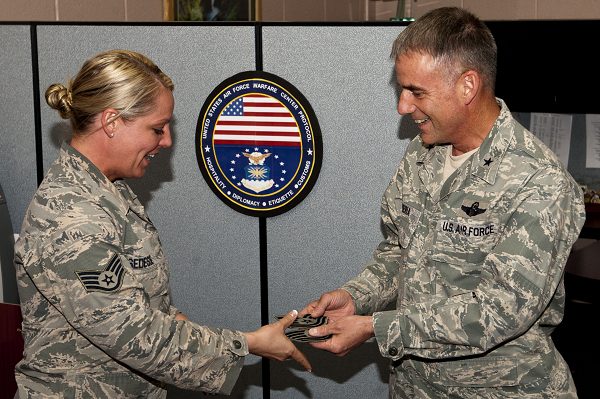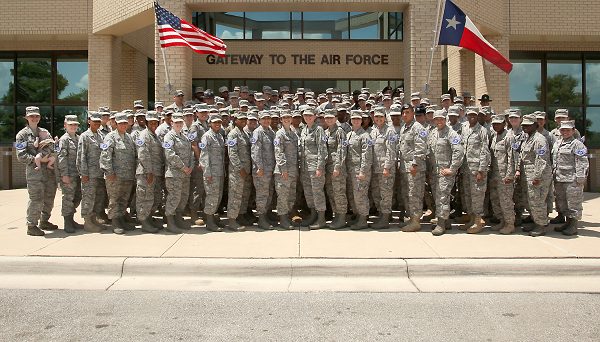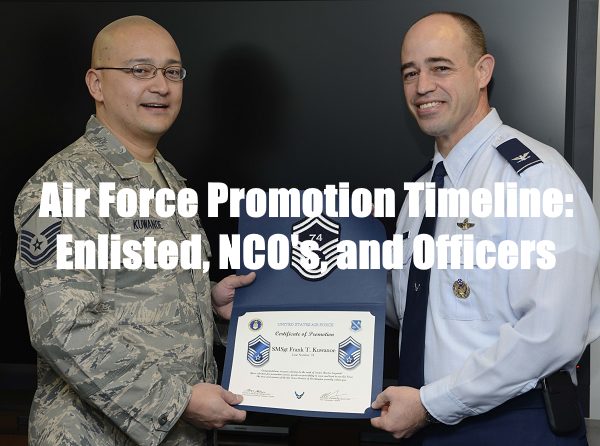To best understand the Air Force Promotion Timeline, you need to know how rank is categorized in the Air Force.
First, the United States Air Force divides its rank into three different categories.
The Airman level is E-1 through E-4 with the letter ‘E’ meaning enlisted.
Also, levels E-5 and E-6 is the Non-Commissioned Officer (NCO) level.
E-7 through E-9 are known as Senior Non-Commissioned Officers.
Afterward, the officer levels are O-1 through O-9.
Also, some promotions are automatic, while others take effort and accomplishments into consideration.
Related Article – Air Force Command And Control Operations
Air Force Promotion Timeline and Skill Level

It is essential to know promotion in the Air Force is dependent upon many factors, including skill level.
Also, the skill level relates to the level of skill gained in on-the-job training.
Furthermore, the skill level typically corresponds to the rank itself.
For example, If you are awarded a three-level, you are eligible to become an Airman First Class.
How Does Time in Service (TIS) and Time in Grade (TIG) impact promotions?
Time in Service (TIS) is the amount of time spent in the Air Force. This date starts from the day you went to basic training.
Also, Time in Grade (TIG) is the amount of time spent in your current rank.
Air Force Promotion Timeline: Airman (Enlisted) Advancement Path
There are four levels of airmen.
- Airman Basic – E-1
- Airman – E-2
- Airman First Class – E-3
- Senior Airman – E-4
First, unless you have earned an advanced rank, everyone enters the Air Force as an Airman Basic (E-1).
Next, after six months of TIG, you automatically advance to Airman (E-2).
Furthermore, to become an Airman First Class (E-3), you need 10 months of TIG.
However, if you initially enlist for six years, you will receive your E-3 designation after completing technical training.
Also, For promotion to E-4, Senior Airman, you’ll need to complete your 3-level in your AFSC and be recommended for promotion. You’ll be eligible for SrA once you have 36 months TIS and 20 months TIG, or 28 months TIG, whichever happens first.
Related Article – 14 Boot Camp Graduation Gift Ideas
Air Force Promotion Timeline: Non-Commissioned Officer (NCO) Path

Non-commissioned officers are Staff Sergeants (E-5) and Technical Sergeants (E-6).
Also, non-commissioned officers hold leadership positions in their units.
However, non-commissioned officers do not have commissioned officer status.
While the promotions through Airman are automatic, there is more to consider for further promotions.
Staff Sergeants (E-5)
Promotion from Senior Airman to Staff Sergeant requires you to go through a 24-day leadership school and a course of professional military education before promotion.
Furthermore, Staff Sergeants need three years of TIS, six months of TIG, and have a skill level of 5.
Also, there is a rating system where Senior Airman gather points for promotion over five factors:
- Time in service
- Time in Grade
- Medals
- Annual performance
- Scores from written tests
Technical Sergeants (E-6)
To promote from a Staff Sergeant to a Technical Sergeant, you must have 23 months TIG and 5 years TIS.
Also, to become a Technical Sergeant, you face the same rating system before consideration for promotion and a skill level of seven.
Air Force Promotion Timeline: Senior Non-Commissioned Officer (SNCO) Path
Senior Non-commissioned Officers include Master Sergeant, Senior Master Sergeant, and Chief Master Sergeant.
Master Sergeant
The rank of Master Sergeant promotion requires a skill level of seven.
You must also complete your Enlisted Professional Military Education Requirements (EPME), which for MSgt, is the NCO Academy.
Also, this promotion is the same as moving from a Staff Sergeant and Technical Sergeant, but it requires eight years of TIS and 24 months of TIG.
Senior Master Sergeant
The promotion to this rank is highly competitive because public law state only 2 percent of the force may be in the Grade of E-8.
Therefore, for promotion, you must have 11 years of TIS and 20 months of TIG.
You must also have completed the SNCO Academy and have an associate’s degree from an accredited academic institution, including the Community College of the Air Force (CCAF).
Also, each year a promotion board gathers to discuss the Senior Master Sergeants and the Chief Master Sergeant promotions.
The promotion board discusses potential promotions.
Also, these promotions are scored based on performance, competence, leadership, responsibilities, achievements, and level of education.
Chief Master Sergeant
Chief Master Sergeant (E-9) is the highest of the enlisted ranks and is also competitive.
Furthermore, promotion requirements include 14 years TIS and 21 months TIG.
Air Force Promotion Timeline: Officer Path
There are regular opportunities for Air Force Officers, as well.
Second Lieutenant
The rank of Second Lieutenant is the lowest officer rank in the commissioned officer classification.
Also, there are several paths to becoming an officer in the Air Force.
These paths include college ROTC programs, attending the Air Force Academy, attending Officer Training School (OTS) after college, or working through the enlisted ranks.
First Lieutenant, Captain, and Major, and Beyond
To move from Second Lieutenant to First Lieutenant, you will need 2 years TIG.
The promotion to Captain requires 2 years TIG, as well.
Also, to become a Major or any rank beyond, there is a highly competitive set of selection criteria.
Related Article – Best Air Force Officer Jobs
FAQ
We addressed some frequently asked questions to help make the promotions timeline as clear as possible.
How Can I Achieve Advanced Rank When I First Enlist in the Air Force?
There are a couple of ways to enter the Air Force with advanced rank.
First, if you participated in the Junior ROTCD training, you would enter the Air Force as an E-2.
Also, you can enter as an E-2 if you have 20 college credits or are an Eagle Scout or Girl Scout Gold.
Furthermore, those who have three years of Junior ROTC training or 45 college credits may enter the Air Force with a rank of E-3.
How Does the Points System Work for Promotion in the Air Force?
After the promotions cease to be automatic at the beginning of service in the Air Force, the Weighted Airman Promotion System, or WAPS, is essential.
Promotion Fitness Examination (PFE)
This exam is 100 questions revolving around responsibilities or leadership, history, and customs. The maximum points are 100.
Specialty Knowledge Test (SKT)
This test is also 100 questions with a maximum score of 100. This test involves career development, and the materials studied to earn the skill level of 5.
Time-in-Grade
You will receive half of a point for each month of service up to 60 for TIG.
Also, TIS earns you two points for each year in the service for a maximum of 40.
Awards
Also, you will receive points for military decorations and awards.
Enlisted Performance Reports (EPR)
Lastly, the yearly performance reports from supervisors factor into the overall rating, as well.
Related Article – Air Force Bonus List: 6 Bonuses Available
Conclusion
When you first enter the Air Force, your promotions coordinate heavily with your TIG and TIS.
As you progress in your military career, the promotions include a point system that takes into consideration your personal accomplishments and your effort.
These extra considerations are necessary due to the internal structure of the Air Force and the availability of higher ranks.
References:
https://www.afpc.af.mil/promotion/
https://www.airuniversity.af.edu/
- Pure Rawz Review: Legit Peptides & SARMS Or Fraud? - November 26, 2023
- American Flag With Circle Of Stars (Betsy Ross) Explained - November 23, 2023
- 20 Best Military War Movies Of All-Time - November 22, 2023


